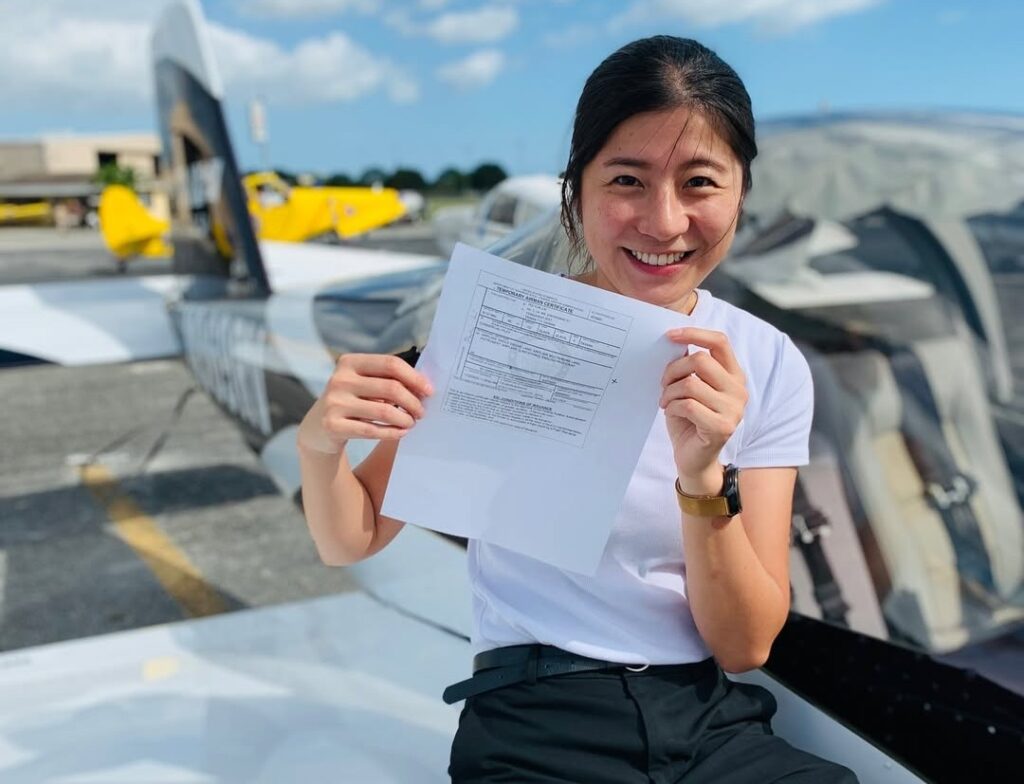Who can become a pilot?
You can become a pilot as long as you meet the medical requirements of the Federal Aviation Administration (FAA), which we’ll discuss later. Dynasty Aviation has helped hundreds of men and women become pilots using our modern aircraft and superior flight training program.

Follow these steps to become a pilot:
Step 1
Research Your School
Not all flight schools are created equal, so comparing your options and choosing one that aligns with your goals and needs is essential. Here are some key questions to ask when evaluating a flight school:
- What happens to my deposits if I decide to stop training?
- Is ground instruction provided one-on-one?
- How old is the fleet of airplanes used for training?
- Are aircraft and instructors readily available?
- Will I have the same instructor throughout?
Step 2
Take a Discovery Flight
Your first experience controlling an airplane is often called a “Discovery Flight” or “Intro Flight.” It’s an exciting opportunity to see if flying is right for you and whether you’d like to take the next step in your journey to becoming a pilot.

You’ll take the controls during this flight and experience firsthand the thrill of piloting the aircraft. Dynasty offers a memorable one-hour flight over the stunning Miami coastline, introducing aviation and breathtaking views.
Step 3
Get Your Certificates
Dynasty Aviation will help you obtain the two following certificates on your first visit to sign up for flight training:
- FAA Medical Certificate
- FAA Student Pilot Certificate
The medical can be obtained through a specialized doctor called an AME (Aviation Medical Examiner). The student pilot certificate can be obtained through your flight instructor.
Step 4
Start Your Flight Training
Begin your aviation career by starting private pilot training to complete the necessary training requirements for your FAA practical test. It takes a minimum of 36-40 flight hours (depending on your course) and two months to complete this.
All Dynasty Aviation lessons are one-on-one, so you can follow your own schedule and learn at your own pace.
Step 5
Pass Your Exams
You’ll need to pass two exams to become an official pilot:
- Private Pilot Knowledge Test
- Private Pilot Practical Test
The knowledge test is a traditional multiple-choice exam given through the FAA.
In the practical test, you demonstrate your knowledge and skills to an FAA-approved DME (Designated Pilot Examiner).
How Long Does it Take to Become a Pilot?
Now that you know how to become a pilot, you may wonder how long it will take. Ultimately, this depends on your determination and schedule, but for someone who is coming in 5x per week, you can expect to complete your training according to the following chart:
| Private Pilot | 2 months |
| Instrument Rating | 2 months |
| Commercial Pilot | 3 months |
| Multi-Engine Addon | 2 weeks |
| Certified Flight Instructor | 1 month |
| Total | 8.5 months |
Once you have your flight instructor or commercial certificate, you can start building towards your ATP (airline transport pilot) required for the airlines. This requires 1,500 total hours and can take 1-2 years while getting paid to fly!
How Much Does it Cost to Become a Pilot?
The costs associated with becoming a pilot vary widely depending on the school and aircraft you choose. Usually, it will be cheaper to fly older airplanes with outdated instrumentation. Dynasty Aviation has the luxury of being both affordable and modern due to the fuel efficiency of the Sling LSA and RV-12iS. This allows us to have brand-new airplanes and avionics while still being cheaper than competitors.
Here’s a breakdown of the minimum costs for Miami’s most popular flight schools as of the time of writing:
| School Name | Total Cost | Avg. Aircraft Age |
|---|---|---|
| ATP | $116,995 | 11 years |
| American Flyers | $94,122 | 8 years |
| Wayman Aviation | $62,420 | 36 years |
| SkyEagle Aviation Academy | $52,460 | 46 years |
| Dynasty Aviation | $45,400 | 1.2 years |
American Flyers emailed us their pricing, as it’s not publicly available. The aircraft age was calculated using as many tail numbers as we could find from the school.
Regardless, that’s quite a bit of dough! If you need help with financing, check out our flight school financing page.

The Bottom Line…
Now you know how to become a pilot! It might seem like a big journey, but every great adventure starts with a single step. No matter which flight school or path you choose, the important thing is to get out there and start. Taking a discovery flight is the perfect way to kick things off—it’s your chance to feel the controls, see the world from above, and truly experience what it’s like to fly.
Once you’ve taken that leap, go ahead and schedule your first lesson. Trust us, you won’t want to stop once you get started.



